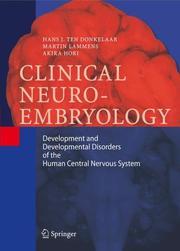| Listing 1 - 2 of 2 |
Sort by
|

ISBN: 3540346597 3540291407 3642067115 Year: 2006 Publisher: Berlin ; New York : Springer,
Abstract | Keywords | Export | Availability | Bookmark
 Loading...
Loading...Choose an application
- Reference Manager
- EndNote
- RefWorks (Direct export to RefWorks)
Combines data from human embryology, animal research and developmental neuropathology. This book provides an overview of the development of the human Central Nervous System (CNS) in the context of its many developmental disorders due to genetic, environmental and hypoxic causes. It highlights numerous clinical cases and contains over 400 figures.
Developmental neurobiology. --- Developmental biology. --- Development (Biology) --- Biology --- Growth --- Ontogeny --- Developmental neurology --- Neurogenesis --- Developmental biology --- Embryology --- Neurobiology --- Nervous system --- Neuroplasticity --- Evolution --- Neurology. --- Neurosciences. --- Neural sciences --- Neurological sciences --- Neuroscience --- Medical sciences --- Medicine --- Neuropsychiatry --- Diseases --- Neurology .
Book
ISBN: 2889193063 9782889193066 Year: 2014 Publisher: Frontiers Media SA
Abstract | Keywords | Export | Availability | Bookmark
 Loading...
Loading...Choose an application
- Reference Manager
- EndNote
- RefWorks (Direct export to RefWorks)
The brain of each animal shows specific traits that reflect its phylogenetic history and its particular lifestyle. Therefore, comparing brains is not just a mere intellectual exercise, but it helps understanding how the brain allows adaptive behavioral strategies to face an ever-changing world and how this complex organ has evolved during phylogeny, giving rise to complex mental processes in humans and other animals. These questions attracted scientists since the times of Santiago Ramon y Cajal one of the founders of comparative neurobiology. In the last decade, this discipline has undergone a true revolution due to the analysis of expression patterns of morphogenetic genes in embryos of different animals. The title of the Research Topic, Adaptive Function and Brain Evolution, stresses the importance of comparative studies to understand brain function and, the reverse, of considering brain function to properly understand brain evolution. This issues should be taken into account when using animals in the research of mental function and dysfunction. The papers of this Research Topic are focused onto the following four Grand Questions of comparative neurobiology: 1) How are different brains built during ontogeny?; 2) What is the anatomical organization of mature brains and how can they be compared?; 3) How do brains work to accomplish their function of ensuring survival and, ultimately, reproductive success?; 4) How have brains evolved during phylogeny?
Comparative neurobiology. --- Neurophysiology. --- Brain --- Brain mapping. --- Anatomy. --- Growth. --- Evolution. --- Connectome mapping --- Mapping of the brain --- Topographic brain mapping --- Nervous system --- Neurobiology --- Physiology --- Comparative neurology --- Localization of functions --- comparative neurobiology --- brain evolution --- phylogeny --- ontogeny
| Listing 1 - 2 of 2 |
Sort by
|

 Search
Search Feedback
Feedback About UniCat
About UniCat  Help
Help News
News